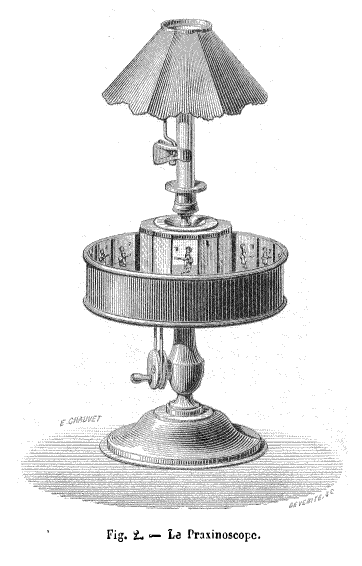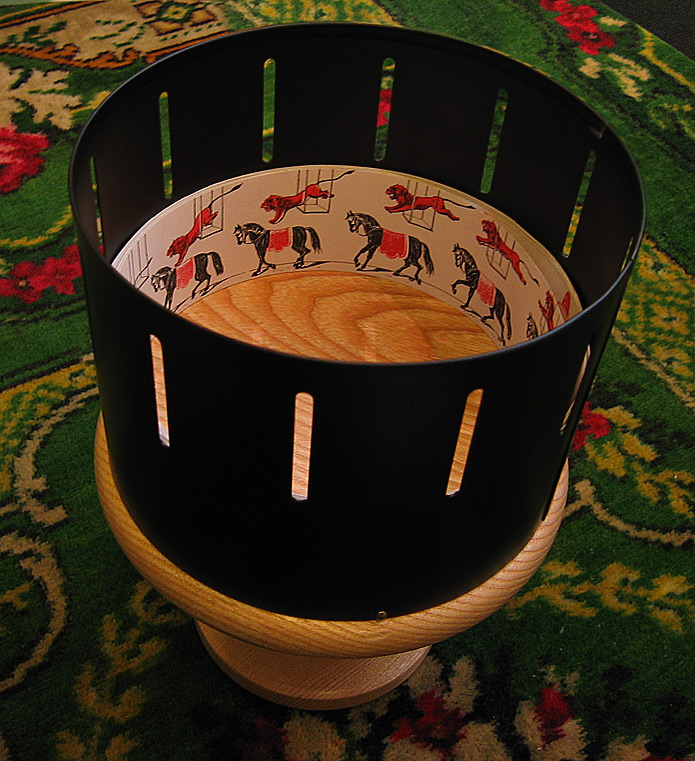|
Praxinoscope
The praxinoscope is an animation device, the successor to the zoetrope. It was invented in France in 1877 by Charles-Émile Reynaud. Like the zoetrope, it uses a strip of pictures placed around the inner surface of a spinning cylinder. The praxinoscope improved on the zoetrope by replacing its narrow viewing slits with an inner circle of mirrors, placed so that the reflections of the pictures appeared more or less stationary in position as the wheel turned. Someone looking in the mirrors can, therefore, see a rapid succession of images producing the illusion of motion, with a brighter and less distorted picture than the zoetrope offered. Variations Reynaud introduced the Praxinoscope-Théâtre in 1879. This was basically the same device, but it was hidden inside a box to show only the moving figures within added theatrical scenery. When the set was assembled inside the unfolded box, the viewer looked through a rectangular slot in the front, onto a plate with a transparent mir ... [...More Info...] [...Related Items...] OR: [Wikipedia] [Google] [Baidu] |
Théâtre Optique
The Théâtre Optique (Optical Theatre) is an animated moving picture system invented by Charles-Émile Reynaud, Émile Reynaud and patented in 1888. From 28 October 1892 to March 1900 Reynaud gave over 12,800 shows to a total of over 500,000 visitors at the Musée Grévin in Paris. His ''Pantomimes Lumineuses'' series of animated films include ''Pauvre Pierrot'' and ''Autour d'une cabine''. Reynaud's Théâtre Optique predated Auguste and Louis Lumière's first commercial, public screening of the cinematograph on 28 December 1895, which has long been seen as the birth of film. Technology The realized films had 300 to 700 transparent pictures of successive phases of moving figures with black backgrounds. The pictures were hand painted by Reynaud in aniline inks directly on 6 x 6 cm gelatin plates. The plates were coated with shellac and framed in a cardboard strip of which the sides were clad in fabric bands attached with split pins. The horizontal film strip could be up to ... [...More Info...] [...Related Items...] OR: [Wikipedia] [Google] [Baidu] |
Animation
Animation is a filmmaking technique whereby still images are manipulated to create moving images. In traditional animation, images are drawn or painted by hand on transparent celluloid sheets to be photographed and exhibited on film. Animation has been recognised as an artistic medium, specifically within the entertainment industry. Many animations are either traditional animations or computer animations made with computer-generated imagery (CGI). Stop motion animation, in particular claymation, has continued to exist alongside these other forms. Animation is contrasted with live action, although the two do not exist in isolation. Many moviemakers have produced films that are a hybrid of the two. As CGI increasingly approximates photographic imagery, filmmakers can easily composite 3D animations into their film rather than using practical effects for showy visual effects (VFX). General overview Computer animation can be very detailed 3D animation, while 2D c ... [...More Info...] [...Related Items...] OR: [Wikipedia] [Google] [Baidu] |
Zoetrope
A zoetrope is a Precursors of film#Modern era, pre-film animation device that produces the illusion of motion, by displaying a sequence of drawings or photographs showing progressive phases of that motion. A zoetrope is a cylindrical variant of the phenakistiscope, phénakisticope, an apparatus suggested after the stroboscopic effect, stroboscopic discs were introduced in 1833. The definitive version of the zoetrope, with replaceable film picture film strips, was introduced as a toy by Milton Bradley Company, Milton Bradley in 1866 and became very successful. Etymology The name ''zoetrope'' was composed from the Greek root words ζωή ''zoe'', "life" and τρόπος ''tropos'', "turning" as a translation of "wheel of life". The term was coined by inventor William E. Lincoln, of Providence, Rhode Island. Technology The zoetrope consists of a cylinder with cuts vertically in the sides. On the inner surface of the cylinder is a band with images from a set of sequenced pictures. ... [...More Info...] [...Related Items...] OR: [Wikipedia] [Google] [Baidu] |
Optical Toys
Optical toys form a group of devices with some entertainment value combined with a scientific, optical nature. Many of these were also known as "philosophical toys" when they were developed in the 19th century. People must have experimented with optical phenomena since prehistoric times and played with objects that influenced the experience of light, color and shadow. In the 16th century some experimental optical entertainment - for instance camera obscura demonstrations - were part of the cabinets of curiosities that emerged at royal courts. Since the 17th century, optical tabletop instruments such as the compound microscope and telescope were used for parlour entertainment or salon Salon may refer to: Common meanings * Beauty salon A beauty salon or beauty parlor is an establishment that provides Cosmetics, cosmetic treatments for people. Other variations of this type of business include hair salons, spas, day spas, ... presentations in richer households. Other, lar ... [...More Info...] [...Related Items...] OR: [Wikipedia] [Google] [Baidu] |
1870s In Animation
Year 187 ( CLXXXVII) was a common year starting on Sunday of the Julian calendar. At the time, it was known as the Year of the Consulship of Quintius and Aelianus (or, less frequently, year 940 ''Ab urbe condita''). The denomination 187 for this year has been used since the early medieval period, when the Anno Domini calendar era became the prevalent method in Europe for naming years. Events By place Roman Empire * Septimius Severus marries Julia Domna (age 17), a Syrian princess, at Lugdunum (modern-day Lyon). She is the youngest daughter of high-priest Julius Bassianus – a descendant of the Royal House of Emesa. Her elder sister is Julia Maesa. * Clodius Albinus defeats the Chatti, a highly organized German tribe that controlled the area that includes the Black Forest. By topic Religion * Olympianus succeeds Pertinax as bishop of Byzantium (until 198). Births * Cao Pi, Chinese emperor of the Cao Wei state (d. 226) * Gu Shao, Chinese official and politic ... [...More Info...] [...Related Items...] OR: [Wikipedia] [Google] [Baidu] |
Audiovisual Introductions In 1877
Audiovisual (AV) is electronic media possessing both a sound and a visual component, such as slide-tape presentations, films, television programs, corporate conferencing, church services, and live theater productions. Audiovisual service providers frequently offer web streaming, video conferencing, and live broadcast services. The professional audio visual industry has companies that provide hardware, software and services. These organizations are commonly referred to as ''systems integrators'' and perform both the installation and integration of different types of AV equipment from multiple manufacturers into spaces to create the AV experience for the user or audience. Computer-based audiovisual equipment is often used in education, with many schools and universities installing projection equipment and using interactive whiteboard technology. Components Aside from equipment installation, two significant elements of audiovisual are wiring and system control. If either of thes ... [...More Info...] [...Related Items...] OR: [Wikipedia] [Google] [Baidu] |
Zoopraxiscope
The zoopraxiscope (initially named ''zoographiscope'' and ''zoogyroscope'') is an early device for displaying moving images and is considered an important predecessor of the movie projector. It was conceived by photographic pioneer Eadweard Muybridge in 1879 (and built for him by January 1880 to project his famous chronophotographic pictures in motion and thus prove that these were authentic). Muybridge used the projector in his public lectures from 1880 to 1895. The projector used 16" glass disks onto which Muybridge had an unidentified artist paint the sequences as silhouettes. This technique eliminated the backgrounds and enabled the creation of fanciful combinations and additional imaginary elements. Only one disk used photographic images, of a horse skeleton posed in different positions. A later series of 12″ discs, made in 1892–1894, used outlines drawn by Erwin F. Faber that were printed onto the discs photographically, then colored by hand. These colored discs we ... [...More Info...] [...Related Items...] OR: [Wikipedia] [Google] [Baidu] |
Strobe Light
A strobe light or stroboscopic lamp, commonly called a strobe, is a device used to produce regular flashes of light. It is one of a number of devices that can be used as a stroboscope. The word originated from the Ancient Greek ('), meaning "act of whirling". A typical commercial strobe light has a flash energy in the region of 10 to 150 joules, and discharge times as short as a few milliseconds, often resulting in a flash power of several kilowatts. Larger strobe lights can be used in “continuous” mode, producing extremely intense illumination. The light source is commonly a xenon flash lamp, or ''flashtube'', which has a complex spectrum and a color temperature of approximately 5,600 kelvins. To obtain colored light, colored gels may be used. Scientific explanation of flashtubes Strobe lights usually use flashtubes with energy supplied from a capacitor, an energy storage device much like a battery, but capable of charging and releasing energy much faster. In ... [...More Info...] [...Related Items...] OR: [Wikipedia] [Google] [Baidu] |
History Of Film
The history of film chronicles the development of a visual art, visual art form created using history of film technology, film technologies that began in the late 19th century. The advent of film as an artistic medium is not clearly defined. There were earlier cinematography, cinematographic screenings by others like the first showing of life sized pictures in motion 1894 in Berlin by Ottomar Anschütz; however, the commercial, public screening of ten Auguste and Louis Lumière, Lumière brothers' short films in Paris on 28 December 1895, can be regarded as the breakthrough of projected cinematographic motion pictures. The earliest films were in black and white, under a minute long, without recorded sound, and consisted of a single shot from a steady camera. The first decade saw film move from a novelty, to an established mass entertainment industry, with film production companies and studios established throughout the world. Conventions toward a general cinematic language develo ... [...More Info...] [...Related Items...] OR: [Wikipedia] [Google] [Baidu] |
Electrotachyscope
The (from German: 'Electrical Quick-Viewer') or Electrotachyscope is an early motion picture system developed by chronophotographer Ottomar Anschütz between 1886 and 1894. He made at least seven different versions of the machine, including a projector, a peep-box viewer and several versions with illuminated glass photographs on a rotating wheel viewed on a wide milk glass screen by up to seven people at the same time. History Before working on chronophotography and motion pictures, Anschütz had already received much acclaim for his instantaneous pictures of flying storks in 1884. In 1885, Anschütz made his first chronophotographs of horses, sponsored by the Prussian minister of Culture. Initially, he used 12 cameras, later on 24. The quality of his pictures was generally regarded to be much higher than that of pioneer Eadweard Muybridge's chronophotographic series. He continued with studies of horses in motion at the (Royal Military Institute) in Hanover during 1886. ... [...More Info...] [...Related Items...] OR: [Wikipedia] [Google] [Baidu] |






